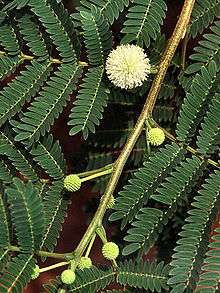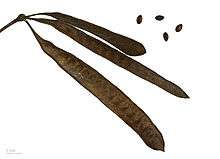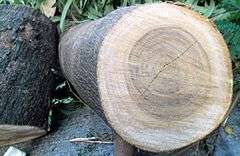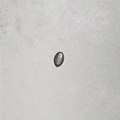Leucaena leucocephala
Leucaena leucocephala is a small fast-growing mimosoid tree native to southern Mexico and northern Central America (Belize and Guatemala)[2][4] and is now naturalized throughout the tropics.
| Leucaena leucocephala | |
|---|---|
 | |
| Scientific classification | |
| Kingdom: | |
| (unranked): | |
| (unranked): | |
| (unranked): | |
| Order: | |
| Family: | |
| Subfamily: | |
| (unranked): | |
| Genus: | |
| Species: | L. leucocephala |
| Binomial name | |
| Leucaena leucocephala | |
| Synonyms | |
| |

Common names include white leadtree,[5] jumbay, river tamarind,[6] ipil-ipil,[7] and white popinac.[8]
L. leucocephala is used for a variety of purposes, such as fencing, soil fertility, firewood, fiber, and livestock fodder.
Use by humans
During the 1970s and 1980s, it was promoted as a "miracle tree" for its multiple uses.[9] It has also been described as a "conflict tree" because it is used for forage production but spreads like a weed in some places.[10]
The legume is promoted in several countries of Southeast Asia (at least Burma, Cambodia, Laos,[11] and Thailand), most importantly as a source of quality animal feed, but also for residual use for firewood or charcoal production.
Forage and fodder
The legume provides an excellent source of high-protein cattle fodder.[12] However, the fodder contains mimosine, a toxic amino acid. Horses and donkeys which are fed it lose their hair.
In many cases this acid is metabolized by ruminants to goitrogenic DHP [3-hydroxy-4(1H) pyridone] in the rumen,[13][14] but in some geographical areas, ruminants lack the organisms (such as Synergistes jonesii) that can degrade DHP.
In such cases, toxicity problems from ingestion of Leucaena have sometimes been overcome by infusing susceptible animals with rumen fluid from ruminants that possess such organisms,[15] and more recently by inoculating cattle rumina with such organisms cultured in vitro.[16]
Such measures have facilitated Leucaena use for fodder in Australia and elsewhere.
Green manure and biomass production
Leucaena leucocephala has been considered for biomass production because its reported yield of foliage corresponds to a dried mass of 2,000–20,000 kg/ha/year, and that of wood 30–40 m³/ha/year, with up to twice those amounts in favorable climates. In India it is being promoted for both fodder and energy.[17].
It is also efficient in nitrogen fixation, at more than 500 kg/ha/year.
It has a very fast growth rate: young trees reach a height of more than 20 ft in two to three years.
Food for humans
The young pods are edible and occasionally eaten in Javanese vegetable salad with spicy peanut sauce, and spicy fish wrapped in papaya or taro leaves in Indonesia, and in papaya salad in Laos[11] and Thailand, where they are known as phak krathin (Thai: ผักกระถิน).[18] In Mexico it is eaten in soups and also inside tacos, it is known as guaje. Additionally, the state of Oaxaca in Mexico derives its name from the Nahuatl word huaxyacac, the name for Leucaena leucocephala trees that are found around Oaxaca City.[19]
Pulpwood for paper industry
Recently, the wood part of the Subabul tree is used for making pulp in the pulp and paper industry. In the southern and central states of India, Subabul is the most important pulpwood species for making pulp. It has huge positive socio-economic impact on the livelihood of the small farmers where Subabul is grown as an industrial crop. This provides an alternate crop choice to the farmers of Andhra Pradesh and Telangana states of India where they are also growing cotton and chillies.
Invasive properties
L. leucocephala is considered one of the 100 worst invasive species by the Invasive Species Specialist Group of the IUCN Species Survival Commission.[10]
It is a highly invasive species in the arid parts of Taiwan, The Bahamas, the Hawaiian Islands, Fiji, Puerto Rico, Hong Kong, South Africa,[20] and northern Australia,[21] as well as in South America and Europe.[22]
The plant is also found in parts of the U.S., including California, Arizona, Texas, and Florida.[23]

It grows quickly and forms dense thickets that crowd out all native vegetation.[24]
In urban areas, it is an especially unwanted species, growing along arid roadsides, in carparks, and on abandoned land. [25] [26]
Other limitations
This species is susceptible to insect infestations. In the 1980s, a widespread loss in Southeast Asia was due to pest attack by psyllids.[27]
In India, this tree was initially promoted for afforestation due to its fast-growing nature. However, it is now considered unsuitable for urban planting because of its tendency to get uprooted in rain and wind. Eight of every ten trees uprooted by wind in Pune are L. leucocephala.[28]
The seeds contain mimosine, an amino acid known to be toxic to nonruminant vertebrates.[9]
Potential as bioherbicidal agent
L. leucocephala is an allelopathic tree. Phytotoxic allelochemicals, such as mimosine and certain phenolic compounds, including p-hydroxycinnamic acid, protocatechuic acid, and gallic acid, have been identified in the leaves of the species.[29] Bioherbicidal activity of L. leucocephala on terrestrial plants[30][31] and aquatic weed water hyacinth[32] were reported.
Gallery

Leaves Flowers and immature fruit 
Pollen 
Pod and seeds 
Subabul growing wild on the outskirts of Mumbai
Notes
- The Legume Phylogeny Working Group (LPWG) (2017). "A new subfamily classification of the Leguminosae based on a taxonomically comprehensive phylogeny". Taxon. 66 (1): 44–77. doi:10.12705/661.3.
- "Leucaena leucocephala, Leucaena leucocephala". Germplasm Resources Information Network (GRIN). Agricultural Research Service (ARS), United States Department of Agriculture (USDA). Retrieved 2010-01-18.
- "Leucaena leucocephala (Lam.) de Wit — the Plant List".
- Hughes, Colin E. (1998). Monograph of Leucaena (Leguminosae-Mimosoideae). Systematic botany monographs v. 55. ISBN 978-0-912861-55-5.
- "PLANTS Profile for Leucaena leucocephala (white leadtree)". PLANTS Database. United States Department of Agriculture. Retrieved 2009-09-19.
- Shelton, H.M.; Brewbaker, J.L. "2.1 Leucaena leucocephala - the Most Widely Used Forage Tree Legume". Food and Agriculture Organization of the United Nations. Retrieved 24 September 2015.
- Matthews, Donald Maxwell (1914). Ipil-ipil: A firewood and reforestation crop (Leucaena glauca (L.) Benth). Forestry Bureau Bulletin. 13. Manila: Bureau of Printing, Philippine Islands, Bureau of Forestry.
- Ipil-ipil, Leucaena glauca, BPI.da.gov.ph
- "2.1 Leucaena leucocephala - the Most Widely Used Forage Tree Legume". www.fao.org. Retrieved 2017-08-04.
- "Leucaena leucocephala (tree)". Global Invasive Species Database. Invasive Species Specialist Group. Retrieved 2010-01-18.
- "Farmers to grow leucaena for animal feed". Vientiane Times. 2011-06-15.
- "Leucaena leucocephala (Lam.) deWit". hort.purdue.edu. Retrieved 8 June 2010.
- Hammond, A. C. 1995. Leucaena toxicosis and its control in ruminants. J. Animal Sci. 73: 1487-1492.
- Allison, M. J., A. C. Hammond, and R. J. Jones. 1990. Detection of ruminal bacteria that degrade toxic dihydroxypyridine compounds produced from mimosine. Appl. Environ. Microbiol. 56: 590-594.
- Allison, M. J., W. R. Mayberry, C. S. Mcsweeney, and D. A. Stahl. 1992. Synergistes jonesii, gen. nov., sp. nov.: a rumen bacterium that degrades toxic pyridinediols. Syst. Appl. Microbiol. 15: 522-529.
- Graham, S. R., S. A. Dalzell, Nguyen Trong Ngu, C. K. Davis, D. Greenway, C. S. McSweeney, and H. M. Shelton. 2013. Efficacy, persistence and presence of Synergistes jonesii in cattle grazing leucaena in Queensland: on-farm observations pre-and post-inoculation. Animal Prod. Sci. 53: 1065-1074.
- Subabul Reloaded: How One Tree Could Be the Answer to India’s Fodder, Fuel Needs; Published in The Better India, 11 February 2019
- ASEAN Biodiversity
- Consular, Gaceta (October 1996). "Oaxaca". MexConnect. Retrieved August 15, 2010.
- "Invasive Species South Africa - Protecting Biodiversity from Invasion - Leucaena | Leucaena leucocephala".
- "Leucaena Leucaena leucocephala". Weed Identification & Information. Australian Weeds Strategy. Retrieved 2009-09-19.
- Fonseca, N.G. & Jacobi, C.M. 2011. Desempenho germinativo da invasora Leucaena leucocephala (Lam.) de Wit. e comparação com Caesalpinia ferrea Mart. ex Tul. e Caesalpinia pulcherrima (L.) Sw. (Fabaceae). Acta Botanica Brasilica 25(1): 191-197. Link: http://acta.botanica.org.br/index.php/acta/article/viewFile/1265/427
- "Leucaena leucocephala (Lam.) de Wit white leadtree". United States Department of Agriculture. Retrieved 8 June 2010.
- Kuo, Yau-Lun. "Ecological Characteristics of Three Invasive Plants (Leucaena Leucocephala, Mikania Micrantha, and Stachytarpheta Urticaefolia) in Southern Taiwan." 12 1 2003.http://www.agnet.org/library/eb/541/ (accessed 3 24 2008).
- Tree Preservation
- "Leucaena leucocephala - Hong Kong Flora and Vegetation". www.hkflora.com. Retrieved 2017-08-04.
- ODI - Alley Farming
- Das, Dipannita (8 May 2011). "Activists want Pune Municipal Corporation to allow cutting of subabul trees in city". The Times of India. Archived from the original on 15 July 2012. Retrieved 9 May 2011.
- Chou CK, Kuo YL (1986) Allelopathic research of subtropical vegetation in Taiwan. III. Allelopathic exclusion of understory by Leucaena leucocephala (Lam.) de Wit. J Chem Ecol 12:1431-1448
- Hong NH, Xuan TD, Eiji T, Hiroyuki T, Mitsuhiro M, Khanh TD (2003) Screening for allelopathic potential of higher plants from Southeast Asia. Crop Protection 22:829-836
- John J, Narwal SS (2003) Allelopathic plants. 9. Leucaena leucocephala (Lam.) de Wit. Allelopath J 12:13-36 OpenURL
- Chai TT, Ooh KF, Ooi PW, Chue PS, Wong FC (2013) Leucaena leucocephala leachate compromised membrane integrity, respiration and antioxidative defence of water hyacinth leaf tissues. Botanical Studies 54: 8.
| Wikimedia Commons has media related to Leucaena leucocephala. |
External links
- M. Suttie, Jim. "Leucaena leucocephala (Lam.) de Wit". Grassland Species Profiles. Food and Agriculture Organization of the United Nations. Retrieved 5 July 2013.
- Handbook of Energy Crops at Purdue University: Leucaena leucocephala
- Economics of Subabul Plantation In Hegde, N.G. and Abhyanker, P.D. (eds.) The Greening of Wastelands.
- Relwani, L.L. & Hegde, N.G. 1986.
- Leucaena leucocephala factsheet
- Pradip Krishen, 'Trees of Delhi a Field Guide', DK publishers, Page 291, 2006